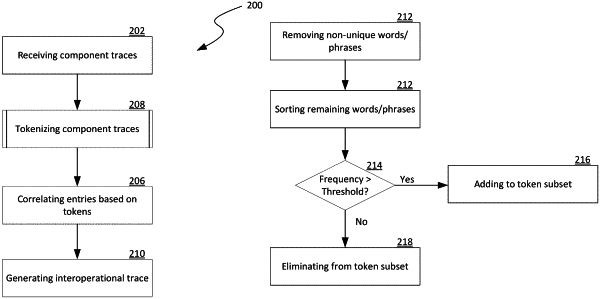| CPC G06F 11/3075 (2013.01) [G06F 16/3344 (2019.01); G06F 16/90344 (2019.01); G06F 40/211 (2020.01); G06F 40/284 (2020.01)] | 20 Claims |

|
1. A method of automated interoperations tracking performed by a server in a distributed computing system having a first software component configured to provide a first computing service and operatively coupled to a second software component configured to provide a second computing service to the first computing service, the method comprising:
receiving, at the server, a first event log from the first software component and a second event log from the second software component, wherein the first computing service having the first software component does not share tracking identifiers with the second computing service having the second software component, and wherein the first event log and the second event log each includes data representing multiple entries each having multiple data fields related to processes executed at the first software component and the second software component;
in response to receiving the first event log and the second event log,
calculating a first set of appearance frequencies for a first set of strings in the first event log; and
calculating a second set of appearance frequencies for a second set of strings in the second event log;
selecting a first subset of strings from the first set of strings in the first event log based on appearance frequencies of the first subset of strings being below a preset frequency threshold;
selecting a second subset of strings from the second set of strings in the second event log based on appearance frequencies of the second subset of strings being below the preset frequency threshold;
mapping a first string in the first subset of strings and a second string in the second subset of strings to a single token based on correlating the single token within the first string and the second string; and
based on mapping the first string and the second string to the single token, generating a new event log that includes a first entry corresponding to the first string in the first subset of strings and a second entry corresponding to the second string in the second subset of strings, wherein the first entry and the second entry are correlated with the single token.
|